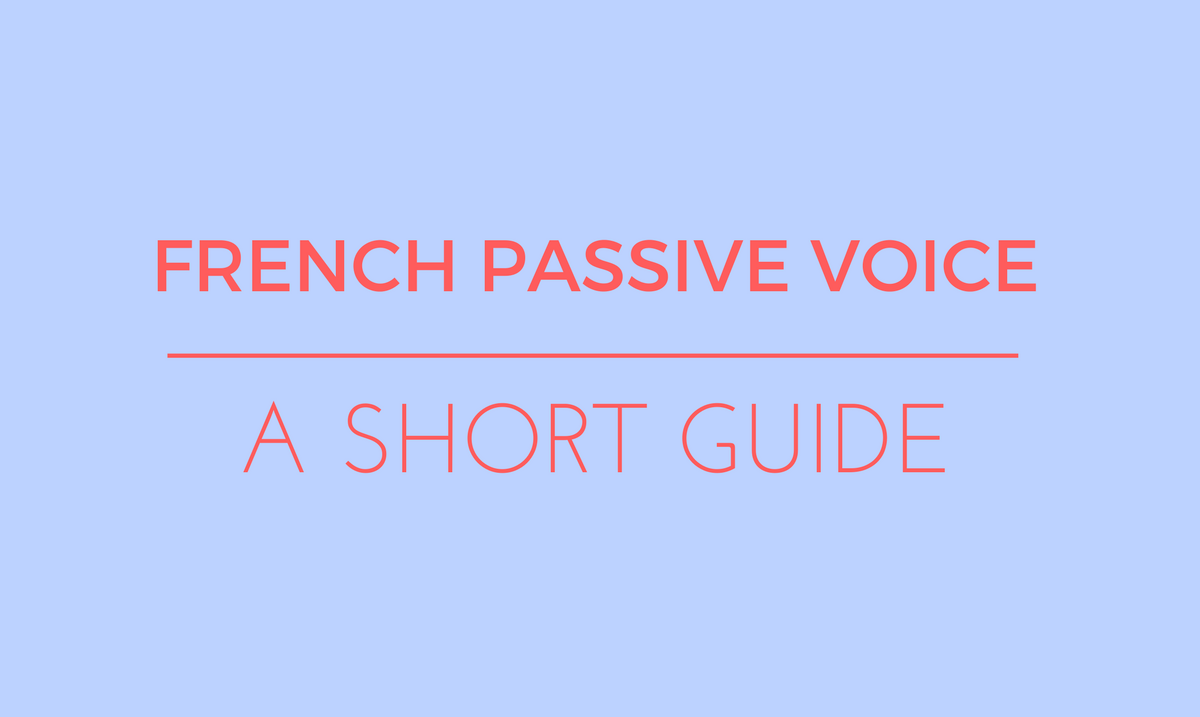Learning how to speak in another language is not easy. But if you already have a working knowledge about English grammar, it will tend to be so much easier, believe me.
Take for example our topic on this article: the passive voice. Are you still familiar with how it works? If not, then here is a quick background.

What is the passive voice?
- It is the manner of constructing a sentence in such a way that the receiver of the action becomes the subject, instead of the one doing the action himself.
- The subject would be presented in such a way that it doesn't do anything, and another agent (the object of the sentence) is the one doing the action to it.
- The subject is the one being affected by the action.
In common conversations, we usually use the active voice where the subject is the one doing the action. In the passive however, the subject is the person or thing that the action happens to.
Here are some examples between the passive and active voice.
Passive: I (the subject) was promoted (the passive verb) by my boss (the agent).
To say it in an active voice, you say:
My boss (the subject) promoted (the active verb) me (the object).
You see the difference? Just as the word itself suggests, it is PASSIVE, meaning, it does not do the action.
Most of the time, however, when the passive voice is used in sentence construction, the agent or the doer of the action is often not mentioned or is unknown.
For example, using the same sentence above: I (subject) was promoted (passive verb).
It is still a passive sentence, but the agent is nowhere to be found in the sentence.
Quick tip:
In English, the passive voice is often avoided in writing and is considered a bad way to write because of the following:
- It makes a sentence too wordy and seems to go around in circles. (example: The flowers on the table were left by Michael as a surprise for Jenny. You could have just said: Michael left the flowers on the table as a surprise for Jenny. It is more direct to the point and less confusing.)
- It often sounds unclear because people are wired to think that an action is done by the subject. Twisting it the other way so that the receiver of the action becomes the subject would lead to some confusion.
- Using the active voice to write makes the writing more dynamic.
There are cases however when the passive voice cannot be avoided, and that is when you do not know who the doer of the action is (example: She was sent a love letter.), or when you want to put an emphasis on the thing or person doing the action. (example: The artwork was painted by a child.)
Still Stuck at Intermediate French?

Break through the plateau with our proven coaching and study method.
English and French Passive
The French passive voice works in the same way as English. So basically, if you understand how the passive is used in English, you should be able to grasp this quickly too.
In English, the method in forming a passive sentence is to use the verb 'to be' paired with the past participle. For example: was promoted, was hit. It is exactly the same with French. Être is used together with the past participle.
In French, however, the passive is not used as often as we do in English. It is usually used for formal speech or when speaking in old school literary tones.
How to Form the Passive Voice
The passive form of the verbs in French is formed by using the following:
the conjugated form of the verb être + the past participle
Here is a list of the conjugated forms of être which you can use to change the tense of the passive sentences that you are forming:
| Pronoun | Present | Future | Imperfect |
| je (j') | suis | serai | étais |
| tu | es | seras | étais |
| il | est | sera | était |
| nous | sommes | serons | étions |
| vous | êtes | serez | étiez |
| ils | sont | seront | étaient |
| Subjunctive | Conditional | Simple Past | Imperative |
| sois | Serais | fus | |
| sois | Serais | fus | sois |
| soit | Serait | fut | |
| soyons | Serions | fûmes | soyons |
| soyez | Series | fûtes | soyez |
| soient | Seraient | furent |
Present participle: étant
Past participle: été
Here we have the easy guide on forming the past participle of the verb when using être.
You start with the infinitive of the verb, and then proceed to the following changes in the ending.
- If the infinitive ends with an -er, replace the -er with -é.
◦ Examples: donner becomes donné, tomber becomes tombé
- If the infinitive ends with an -ir, remove the r at the end
◦ Examples: finir becomes fini, partir becomes parti
- If the infinitive ends with a -re, replace the -re with -u.
◦ Examples: attendre becomes attendu, descendre becomes descendu
◦ Irregular verbs in the past participle are the same in perfect tense.
The past participle of the verb following être has to agree with the subject of the passive verb (not with the agent of the action).
To make the past participle agree, you add the following endings:
| Masculine endings | Examples | |
| Singular | - | tombé parti descendu |
| Plural | - s | tombés partis descendus |
| Feminine Endings | Examples | |
| Singular | -e | tombée partie descendue |
| Plural | -es | tombées parties descendues |
This lesson is in a way quite similar to the topic perfect tense. So if you need to brush up on that topic, you may proceed to the article Learning French Tenses: Perfect Tense also on this website.
Ways to Avoid the Passive Voice
As mentioned earlier, the passive is not widely used in common discussions in French. So if you find yourself wanting to avoid using the passive voice, here are ways on how to do it:
1. The scenario: you want to put emphasis on or want to highlight the agent of the action.
How to avoid using the passive: Use c'est (or it's in English).
Let's see how this works by using the example we used earlier:
Passive: The artwork was painted by a child. L'oeuvre d'art a été peinte par un enfant.
Change it to:
It's a child who painted the artwork. C'est un enfant qui a peint l'oeuvre d'art.
2. By using the indefinite pronoun 'on' which literally means “one” and can stand for just about anything.
Some examples:
On leur a envoyé une lettre. (Someone sent them a letter.)
On m'a dit que tu ne venais pas. (They told me you weren't coming.)
3. By using reflexive verbs.
If you can remember the discussions on previous lessons on this website, reflexive verbs in French appear with the pronoun se or the shortened form s' before it. These action words are used when the subject is the same person as the object. To put it simply, it means “to____ oneself”.
Example:
Les melons se vendent 3 euros la pièce. (Melons are sold for 3 euros each.)
A Quick Recap on the Topic:
- In the passive voice, the receiver of the action becomes the subject, instead of the one doing the action himself.
- The passive form of the verbs in French is formed by using the conjugated form of the verb être + the past participle.
- The past participle of the verb following être has to agree with the subject of the passive verb (not with the agent of the action).
- The passive voice is not often used in French. To avoid using it, there are alternative ways such as using the indefinite pronoun “on”, by using c'est, or through the help of reflexive verbs.
Learning French is not easy, especially the grammatical topics. We suggest that you come back to this page as often as you like so that you can fully familiarize yourself with the many rules. Most importantly, enjoy your study of the vibrant French language.
Cheers!
P.S. You would be doing me a HUGE FAVOR by sharing it via Twitter or Facebook.
Still Stuck at Intermediate French?

Break through the plateau with our proven coaching and study method.
Here are some FAQs about French Passive Voice
How do you use the passive voice in French?
The French passive voice works the same as English. In English, you convert a normal active voice sentence (subject–verb–object) to passive voice by switching the place of subject and object, and making the verb passive.
For example: “I cooked pasta” becomes “The pasta was cooked by me.”
It’s the same in French, but the verb is made passive by using the conjugated être with the past participle.
J’ai été vaincu par un enfant. (I was defeated by a child.)

C’est utile et bien organise .
[…] Learning the French Passive Voice Learning how to speak in another language is not easy. But if you already have a working knowledge about English grammar, it will tend to be so much easier, believe me. Take for example our topic on this article: the passive voice. Are you still familiar with how it works? If not, then here is a quick background. It is the manner of constructing a sentence in such a way that the receiver of the action becomes the subject, instead of the one doing the action himself. The subject would be presented in such a way that it doesn’t do anything, and another agent (the object of the sentence) is the one doing the action to it. The subject is the one being affected by the action. In common conversations, we usually use the active voice where the subject is the one doing the action. In the passive however, the subject is the person or thing that the action happens to. Here are some examples between the passive and active voice. Passive: I (the subject) was promoted (the passive verb) by my boss (the agent). To say it in an active voice, you say: My boss (the subject) promoted (the active verb) me (the object). You see the difference? Just as the word itself suggests, it is PASSIVE, meaning, it does not do the action. Most of the time, however, when the passive voice is used in sentence construction, the agent or the doer of the action is often not mentioned or is unknown. For example, using the same sentence above: I (subject) was promoted (passive verb). It is still a passive sentence, but the agent is nowhere to be found in the sentence. The French passive voice works in the same way as English. So basically, if you understand how the passive is used in English, you should be able to grasp this quickly too. In English, the method in forming a passive sentence is to use the verb ‘to be‘ paired with the past participle. For example: was promoted, was hit. It is exactly the same with French. Être is used together with the past participle. In French, however, the passive is not used as often as we do in English. It is usually used for formal speech or when speaking in old school literary tones. The passive form of the verbs in French is formed by using the following: Here is a list of the conjugated forms of être which you can use to change the tense of the passive sentences you are forming: Present participle: étant Past participle: été Here we have the easy guide on forming the past participle of the verb when using être. You start with the infinitive of the verb, and then proceed to the following changes in the ending. If the infinitive ends with an -er, replace the -er with -é. ◦ Examples: donner becomes donné, tomber becomes tombé If the infinitive ends with an -ir, remove the r at the end ◦ Examples: finir becomes fini, partir becomes parti If the infinitive ends with a -re, replace the -re with -u. ◦ Examples: attendre becomes attendu, descendre becomes descendu ◦ Irregular verbs in the past participle is the same in perfect tense. The past participle of the verb following être has to agree with the subject of the passive verb (not with the agent of the action). To make the past participle agree, you add the following endings: This lesson is in a way quite similar to the topic perfect tense. So if you need to brush up on that topic, you may proceed to the article Learning French Tenses: Perfect Tense also on this website. As mentioned earlier, the passive is not widely used in common discussions in French. So if you find yourself wanting to avoid using the passive voice, here are ways on how to do it: 1. The scenario: you want to put emphasis on or want to highlight the agent of the action. How to avoid using the passive: Use c’est (or it’s in English). Let’s see how this works by using the example we used earlier: Passive: The artwork was painted by a child. L’oeuvre d’art a été peinte par a un enfant. Change it to: It’s a child who painted the artwork. C’est un enfant qui a peint l’oeuvre d’art. 2. By using the indefinite pronoun ‘on’ which literally means “one” and can stand for just about anything. Some examples: On leur a envoyé une lettre. (Someone sent them a letter.) On m’a dit que tu ne venais. (They told me you weren’t coming.) 3. By using reflexive verbs. If you can remember the discussions on previous lessons on this website, reflexive verbs in French appear with the pronoun se or the shortened form s’ before it. These action words are used when the subject is the same person as the object. To put it simply, it means “to____ oneself”. Example: Les melons se vendent 3 euros la pièce. (Melons are sold for 3 euros each.) Learning French is not easy, especially the grammar topics. We suggest that you come back to this page as often as you like so that you can fully familiarize yourself with the many rules. Most importantly, enjoy your study of the vibrant French language. Cheers! Related PostsFrench Conjunctions – Les Conjonctions: Everything you need to knowFrench Present Participle – The complete guideFrench Adverbs – The polyvalent workersCommon mistakes made by English speakers in French Get our awesome newsletter (Bonus: Get our free study guide to learn French) Get additional free vocabulary list, exclusive discount and so much more directly delivered to our […] […]
this is fab 🙂 Thanks